Hyderabad Style Mutton Biryani
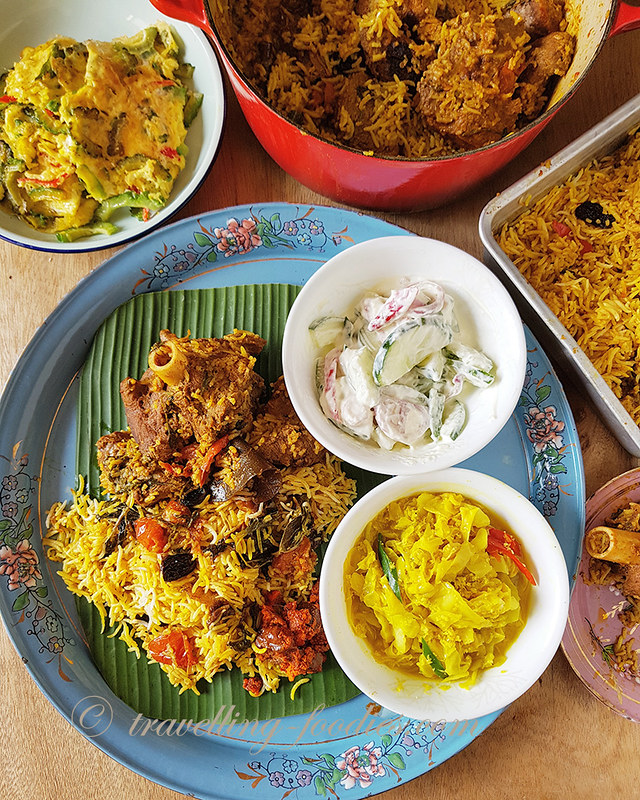
Biryani or “Briyani” as it is being pronounced by some folks here in Singapore, is what I looked forward to enjoy on Fridays as it was offered only on this day in the past. Nowadays many hawker stalls have it on their daily menu. It is synonymously associated with the Indian Muslim food stalls here in Singapore alongside Roti Prata or “Indian Rojak”, where the mutton curry and the basmati rice are cooked separately though the traditional way of preparing this dish in India and parts of Middle East is to have them cooked together. Here’s my take of this very traditional dish from my very own kitchen…
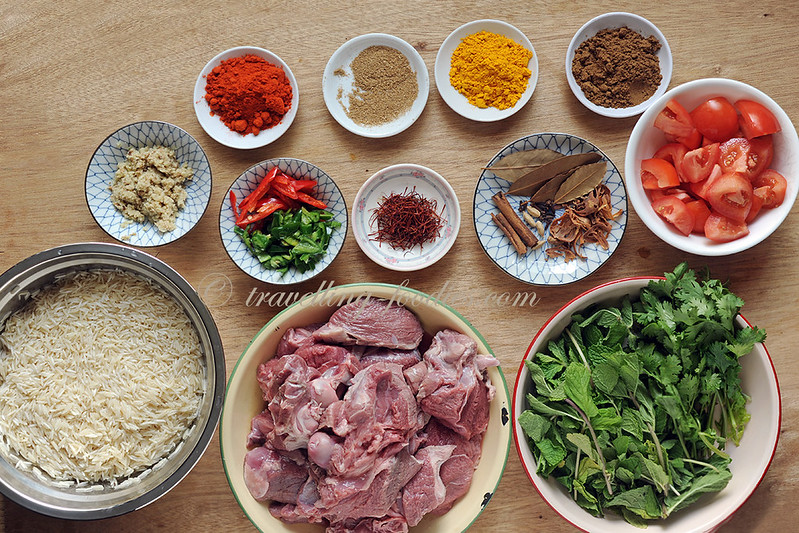
The ingredients for preparing biryani is quite extensive, owing to the range of spices and herbs used. Together, they form a complex bouquet of flavours and aromas which help to build the taste of a good biryani which many of us are familiar with.
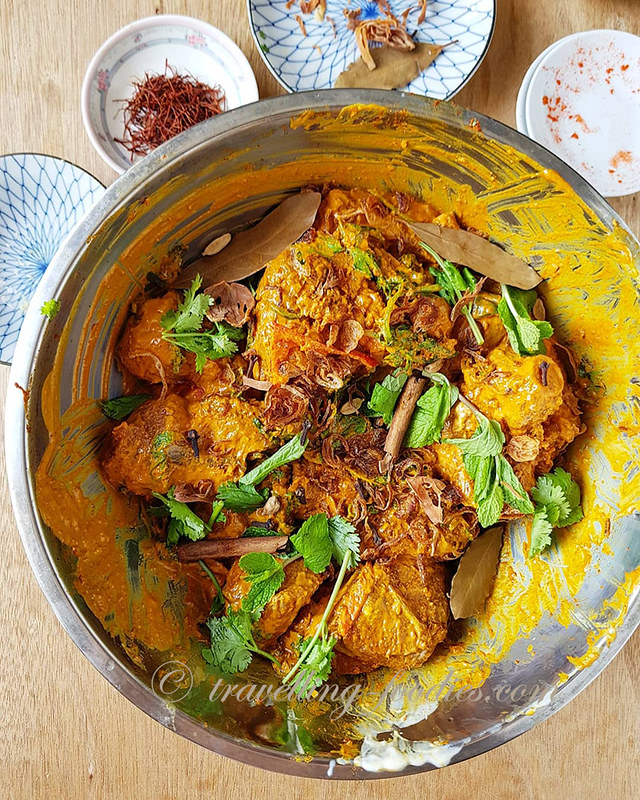
The first part of the prep work has to do with the marination of the lamb. Mise en place for the lamb involves using the standard blend of chili powder, freshly ground coriander powder, garam masala powder, turmeric powder, ginger paste, garlic paste, bombay onion paste and a generous amount of salt to form a thick concoction with lots of greek yoghurt/curds for the acridity and ghee/butter for the smoothness, before slathering and massaging everything by hand unto the chunks of lamb leg, and then the final rub in of the traditional whole spices like fresh chopped chillies, cinnamon/cassia bark, cloves, caraway seeds, bits of cumin, bay leaves, green cardamom and mace, as well as copious amounts of fried shallots, fresh mint and coriander leaves…
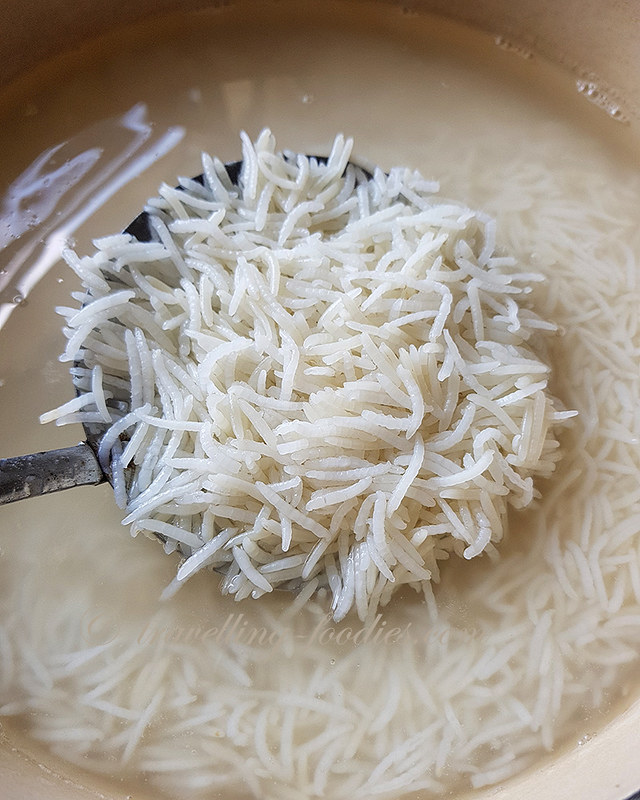
The choice of rice de facto for cooking biryani is with long grained basmati. I often get a question, “what brand of rice did you use?” I have no answer to that as the rice I bought is “nameless” as it was repackaged by the little shop in Little India where I bought it from, who imported the rice in large sacks. The important thing about cooking the basmati is the soaking and the parboiling. Soaking helps to work the moisture into the grains so as to shorten the cooking time. Salt is added to both the soaking and parboiling to ensure that the rice is fully flavoured as the rice is simply left to steam above the marinated lamb in the final stage of the cooking process. “How to keep the grains so long and beautiful?” some of you might ask. Well, it is important to avoid disturbing the rice too much during the initial soaking, parboiling process, and to ensure that the parboiled rice is spread as carefully as possible over the lamb during the cooking.

Saffron, used to be the most expensive spice in the world but “dethroned” by vanilla in the last 2 years. An absolute must in cooking the basmati of any good biryani. The best saffron comes from Iran where the origins of biryani cooking lies too, in the ancient lands of Persia middle East. While the use of saffron extends eastwards to the colloquial forms of “nasi briyani” in our region, glimpses of the influence of middle eastern cuisines through the use of saffron also perpetuates into European cooking, most evidently in the Italian classic risotto milanese and of course the popular Spanish paella…
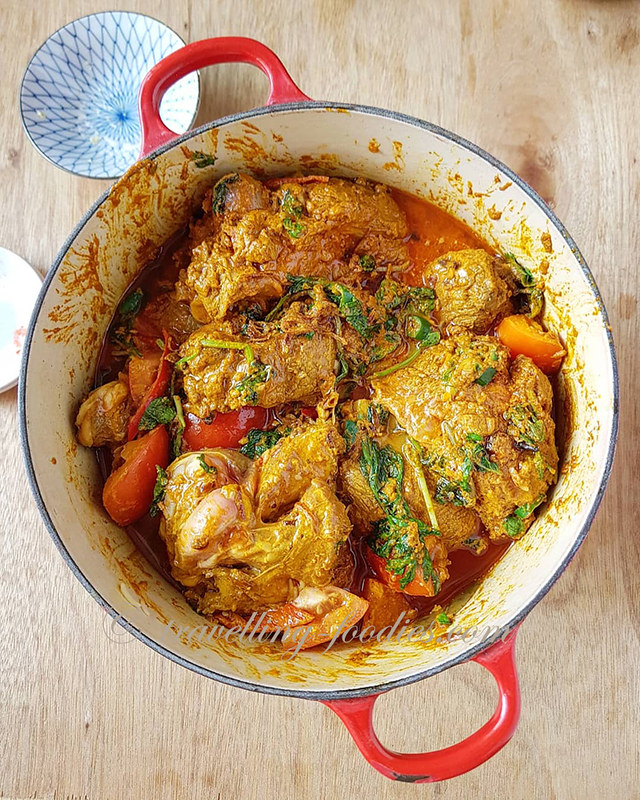
The lamb chunks are first very briefly sauted in the french cast iron casserole I am using before adding chopped tomatoes and giving everything a good mix in before spreading the parboiled rice over.

After the rice is spread over the lamb, the top is added with more chopped coriander and mint leaves, fried shallots, raisins, butter and of course the golden yellow solution from soaking saffron strands with some of the hot water used to parboil the rice earlier. After that, it is just a simple matter of covering the pot with a very heavy lid and then letting the heat from the stove and then the oven to do their work of slow cooking the lamb and rice until tender…
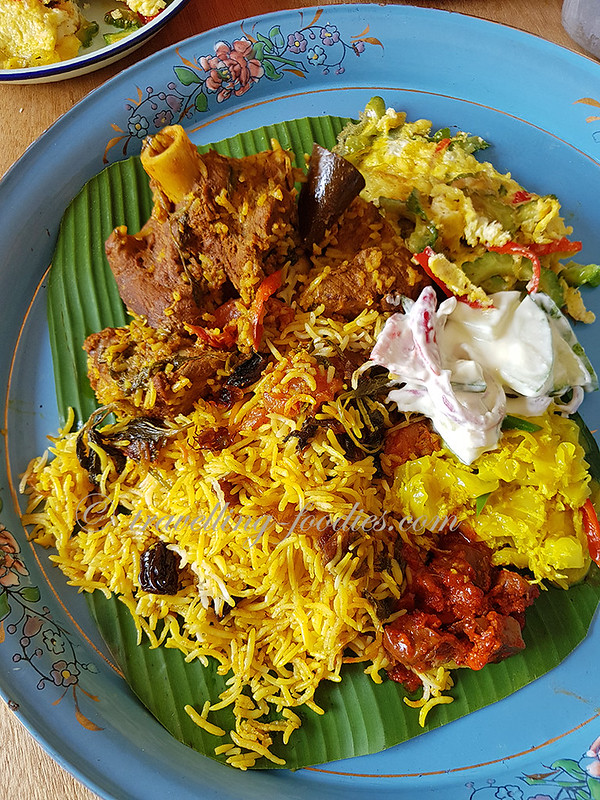
There is always an element of surprise if everything would turn out well when cooking biryani at home. Would the basmati rice be pillow-like fluffy yet not mushy? Would the lamb turn out fork tender and not too dry? Would the flavours be robust yet balanced, striking yet complimenting? Thankfully all turned out pretty well. I started on the cooking over the stove but finished in the oven, an acceptable twist I reckon to simulate the traditional “dum biryani” cooking method done over coals. Using a 24 cm le creuset dutch oven which comes with a heavy cast iron lid, I saved myself the trouble of sealing the edges with an atta dough to trap the steam, though I did add on another heavy lid, that of the 28cm casserole for extra measure. Prepared 3 sides to go with the biryani while the pot of rice and lamb is slowly cooking in the oven. A quick South Indian inspired turmeric cabbage with grated coconut stir fry, a bittergourd omelette to counterbalance the “heat” from the mains and of course a refreshingly tart cucumber raita which is an absolute must to go with biryani. I also scooped a generous dollop of mango achar as a side, homemade by members of the Melakan Kristang community residing at the Portuguese settlement in Ujong Pasir, something precious to me and have been saving for that “special occasion”. Today’s biryani cooking session seemed most befitting…
Hyderabad Style Mutton Biryani
serves 6-8
Ingredients
2 kg of lamb leg, chopped into chunks
80-100g fresh mint leaves, chopped coarsely
80-100g fresh coriander leaves, chopped coarsely
1 cup fried shallots
3-4 cups basmati rice
water for soaking and parboiling rice
1/2 cup raisins (optional)
1/2 cup cashew or almond (optional)
pinch of saffron
3-4 tbsp melted ghee/butter
Marinade Ingredients
2 tbsp red chili powder
1 tbsp coriander powder
1 tbsp turmeric powder
1 tbsp garam masala powder
2 sticks of cinnamon/cassia bark, snapped into halves
4 cloves
4 green cardamon pods
1 tbsp mace
1/2 tsp cumin seeds
1/2 tsp caraway seeds
4-6 bay leaves
2 red chilies, chopped
2 green chilies, chopped
1 cup greek yoghurt or curds
1/2 cup melted butter or ghee
2 tbsp salt
50g garlic paste
50g ginger paste
150g bombay onion paste
100-120g green papaya paste (natural meat tenderiser, optional)
Method
Mix all the marinade ingredients in a large mixing bowl to form a thick slurry.
Pour in lamb chunks and massage the pieces with the marinate paste until everything is well coated. Add half of the coriander leaves, mint leaves, fried shallots, mix well and set aside to marinate for at least 1 hour.
Rinse the basmatic rice well until the water turns clear and then top with more water to cover the grains. Add 1 tbsp salt and set aside to soak for 30-45 min.
Bring a large pot of water to boil and add drained basmati rice grains. Make sure that the boiling water covers the grains by at least an inch. Bring to a boil before lowering a gentle simmer for 8-10 min or until the rice grains are around 70% cooked.
Drain the partially cooked rice and set aside.
To a small bowl, add saffron strands and 3-4 tbsp of the hot water used in parboiling the rice. Mix well and set aside.
To a large pot or casserole, add some oil and then the marinated lamb chunks. Saute briefly before adding chopping tomatoes.
Spread the parboiled rice over the top carefully. Sprinkle raisins and the remaining chopped coriander leaves, mint leaves, fried shallots over the rice.
Drizzle saffron water and strands over the top of the rice and add the melted ghee/butter.
Cover and cook over the stove with medium high heat until the mixture begins to boil slightly. Lower heat to the lowest possible and cover tightly. Add weights like another heavy lid over the top if necessary to help contain the steam within the pot as the lamb and rice is cooked with its only moisture. If required, seal the edges of the cover with a dough made simply out of flour and water but this was unnecessary for me as I was using a cast iron casserole and topped with another heavy lid.
Slow cook for 45 min to 1 hour over the stove.
Otherwise, cook over the stove for 30min and then transfer to a pre-heated oven at 170 degrees Celsius and continue to cook for another 1 hour until the meat is tender.
Rest the pot for another 20-30 min covered.
Fluff the rice carefully in order not to break the grains and serve immediately while hot with other side dishes like raita or some mango pickle.

nice recipes
February 16, 2019 at 12:22 pm
Hi Alan
Lama tak dengair!
I miss your posts! Always enjoyed reading and trying out your recipes!
March 18, 2019 at 8:14 pm
mmmmmmm delish
October 15, 2019 at 3:38 pm